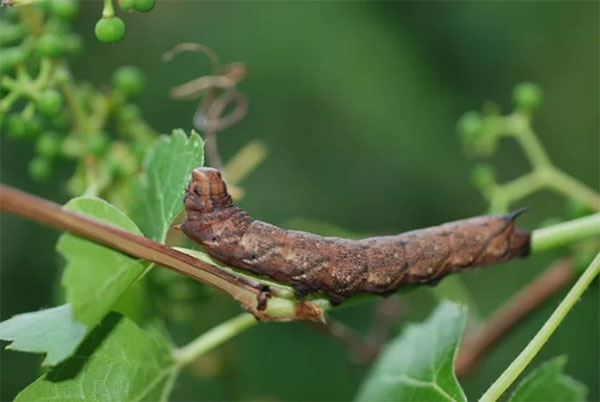
The fall armyworm (Spodoptera frugiperda) moth has invaded our country at the end of the year, and the insect is the eponym of an insect pest, an insect pest and a stranger to our country.
The moth’s caterpillar has been affected by various types of crop including 100 kinds of maize, corn, sugarcane, rice, vegetables and fruits. Today, the caterpillars have been reported from all parts of the country. ç This caterpillar is rapidly spreading in Sri Lanka due to maize cultivation. According to the existing data, the total area of maize cultivated has been 81,855 hectares out of 48,555 hectares. In addition to the maufactulum, kurakkan, sugar cane and vegetable crops have been damaged.
life cycle
A mature female moth puts 50 to 250 eggs at once, and often feeds the eggs on the lower leaves. In between 2 – 5 days, these eggs break and small caterpillars larvae. The caterpillars start catering immediately after eating from the eggs and turn into six stages.
Often, the first two crannies appear on the underside of the leaf collectively, leaving the leafy flesh and matured, with the base of the apex on the base of the leg to hide in a safe place or hide in the fruit. The caterpillars begin to damage the spreading crop throughout the field, as the caterpillars’ fast food style and food matches each other.
It is very rare to see two grown caterpillars living in one place, since there is a cannibalism in each of these caterpillars. The caterpillars are mature and the color of the body changes from light to green to brown.
Elderly caterpillars can be found in green, yellow, brown, eaten, caterpillar growth, and environmental factors. As soon as the eggs are born, the caterpillars are about one millimeter short and about 3 to 4 centimeters (3 to 4 inches) in 2-3 weeks. The inscription of the inverted English Y (Y) letter and the end of the segment of the final segment of the head is made to distinguish the caterpillars from the other caterpillars from the other caterpillar. Moreover, the caterpillar’s face can see four spots in each section.
As the caterpillar grows, the damage done by the animal increases, and the last two keels are very damaging. Cultivated caterpillars travel to the soil and are cirrhable in soil and can see brownish brown spots in the soil at a depth of 2 to 8 cm. Puppets mushroom after 7 or 10 days. These mothers have the opportunity to fly about 100 kilometers a day before laying eggs before bouncing. Both mothballs and moths are active during the night and complete several life cycles per year. The time taken to complete a life cycle and the life span cycles within a year will depend on food intensity and environmental factors.
Identifying harm
In the early stages of the damage, small larvae have plenty of transparent, visible spots on the leaves due to leaflet from the bottom of the leaf surface. The damage caused by the growth of these larvae is severe, and the leaf is eaten by leaf spawning. In the case of growing caterpillars in the maize, it is possible to damage the apical bud during the aging period, causing damage to the droplet from the legs of the leaves of the land. During the eruption, the seeds enter the grains and eats the seeds. The slags, such as wood dust, which are collected near the drove, also help identify the damage. The damage caused by the damaged crop also varies.
control
The pest control is somewhat inconvenient because of the large number of eggs at a time, the completion of several life cycles per year, the availability of a wide range of crops, and the ability to fly around 100 kilometers a day. But now the pest has controlled the epidemic of most of the cultivated land. However, it was reported that the destruction of the corn crop was not identified at the initial stage and there were occasions where the cultivation was to be destroyed to control the spread.
When such a strange aggressive pest is spreading rapidly in the country, we need to take immediate action to prevent epidemics and the spread of epidemics. Such as Spinotram, Eminentbensoat, Spinoza, can be used for insect pests.
Once the insecticides have the ability to resist resistance to insecticides, they have to re-invoke an insecticide once again to control the use of an insecticidal pesticide in a different functional activity of the pesticides used in the first application. If proper use of insecticidal practices is not used properly, no effective results can be obtained.
The caterpillar’s first keel catches more sensitive to insecticides, and they inhabit the bottom of the leaves. Therefore, it is better to use insecticides at this time. Most of the pesticides recommended for this type of insecticide are gambling and gastric, and since the caterpillars are hiding after the second pit, they are less likely to be exposed to insecticides.
Therefore, spraying the pesticides should be done spraying well with a hot-drink ovalpak with a liquid sprayer. The cornstalk and leaf that has been formed by the base leaves of the maize must be sprayed with pesticides.
Insecticides This caterpillar does not have a long-term solution to repression and it is necessary to adopt integrated pest control methods. Integrated Pest Management means that all pesticide control systems can be used to reduce the density of the pests to the most economically disadvantaged level.
The clusters can be collected and destroyed by hand when the eggs are nestled and the eggs are released from the eggs. To do this, the cultivation crop should be monitored once a week, and the fruitful crop should be checked at least every 15 days.
It is also suitable for spraying ash on the foliage, as well as sprinkling of the spring sand before sunset. Here, ash combines with dew drops and inflicts on the skin of the caterpillars. As the holes in the caterpillar dive through the small holes in the skin, the breathing is blocked and dies. The skin also dries the skin through the gentle sand and dies. It is also possible to control the population by destroying the crop residues and destroying the harvesting horns.
After harvesting, the soil can fall to a depth of 6 to 7 centimeters, causing damage to the soil inside the soil. The spread can also be controlled by avoiding the cultivation of this crop or of these caterpillars at infected cultivation areas. It is possible to control the menace at the proper seasonal crops, use the cultivation methods such as seedlings, seasonal use, aggregate shift at all times. When using chemical fertilizers, fertilizer should be applied at optimum level and no longer apply nitrogen fertilizer. Weeding suppresses additional host trees.
In addition to these methods, we must address short-term and long term solutions. It is also important to introduce resistant strains to the culprit. Seed remedies can also reduce the damage of the stage. Using pheromone traps, you can control the population. Attracted by male moths to the Pheromone trap, the success of the Department of Agriculture has proved its success. It is also learned that these will be introduced to the market soon.
There are parasites, predators and pathogens, the natural enemies of the pest. For example, there are also predators, such as birds and spiders on our cultivated land, for example. Unattractive mothers are active at night, and many insect species are present in our country.
Further, a comprehensive study of parasites and pathogens should be carried out. This should lead to the release of natural enemies into the environment and the conservation of biological pests on the ground. Countries like the United States of America are using biologically advanced biological methods, and they need to focus on the potential for introducing new biomeduces through longer studies.
To identify the damage at the early stages and to educate farmers to systematically implement insecticides at the proper time, this is the primary and essential step in preventing epidemics. Some farmers do not have a proper understanding to suppress these caterpillars using very toxic pesticides without the recommendation of the Department of Agriculture. This will open up the future paths to many agricultural, environmental and socio economic issues.
As mentioned earlier, the caterpillar can not only be successfully eliminated through the use of pesticides, but by using several methods that can be used simultaneously, one strategy can produce more effective results.






